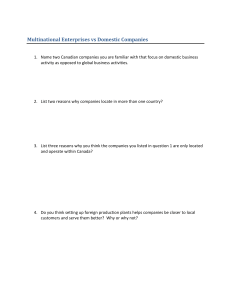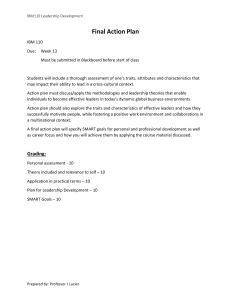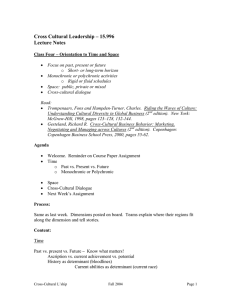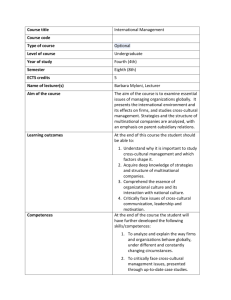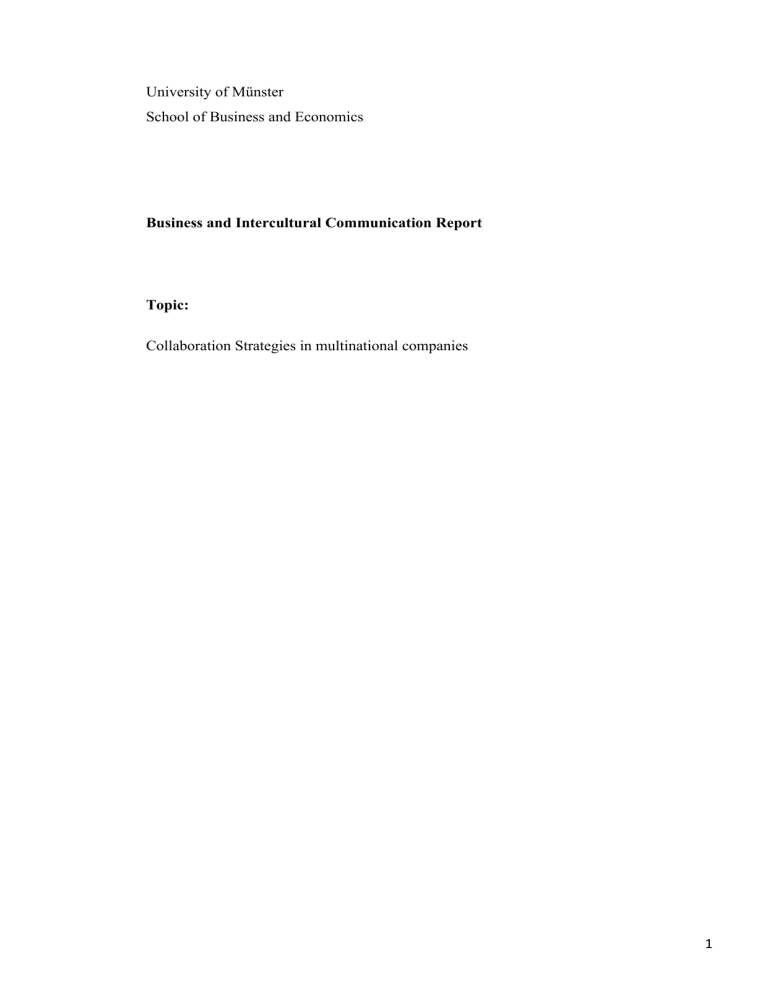
University of Münster School of Business and Economics Business and Intercultural Communication Report Topic: Collaboration Strategies in multinational companies 1 Table of Contents 1. Introduction .......................................................................................................................3 2. Description of cultural challenges ....................................................................................3 2.1 Different communication styles............................................................................................. 4 2.2 Perception of time................................................................................................................... 4 2.3 Trust ........................................................................................................................................ 5 3. Collaboration strategies in a globalized world .................................................................5 3.1 Communication is key ............................................................................................................ 5 3.2 Trust is everything.................................................................................................................. 6 4. Conclusion .........................................................................................................................6 Bibliography ..........................................................................................................................7 2 1. Introduction If a multinational company implements collaboration strategies to overcome cultural barriers throughout its organization, it can create useful synergies, substantially increase productivity and profit from the full potential of diversity. A multinational company is defined as “any corporation that is registered and operates in more than one country at a time”1. Typically, these companies have many employees, manage a lot of capital and have an influential role in politics and the economy. Multinational companies often move production to developing countries overseas with lower wages in order to reduce the cost of goods. This gives multinational firms a competitive advantage. However, just because an idea is simple does not mean its easily implemented. Oftentimes intercultural differences within multinational company can lead to inefficiency and even overall inefficacy. This report will focus on collaboration strategies to overcome common misunderstandings and intercultural blunders in communication within multinational companies. 2. Description of cultural challenges People around the world come from hundreds even thousands of cultural backgrounds. Culture is defined as “the customary beliefs, social forms, and material traits of a racial, religious, or social group”2. For a multinational company it can be difficult to create a uniform corporate culture that is accepted by individuals that are so accustomed to their own culture. Oftentimes people of one naturally culture act in one way that is directly contrasting the natural values of another. It takes empathy, tolerance, a little bit of curiosity and a lot of time to become better at dealing with conflicts that result from cross-cultural misunderstandings.3 Misunderstandings can occur due to a number of reasons. In the following we will look at three cultural challenges in a business context that often lead to confusion and an overall loss of business. 1 THE EDITORS OF ENCYCLOPAEDIA BRITANNICA, Definition of multinational corporation, https://www.britannica.com/topic/multinational-corporation 2 THE EDITORS OF MERRIAM-WEBSTER, Definition of culture https://www.merriamwebster.com/dictionary/culture 3 Cf. ARIRIGUZOH, S., Communication competencies, culture and SDGs:, 2022, https://www.nature.com/ 3 2.1 Different communication styles Cultures have their own communication style; some are very forward and others expect you to get the meaning of what is being said. The direct approach is often favored by the USA, Canada and European countries such as Germany, Netherlands or Denmark. These countries highly value linear communication, efficiency in communication and addressing issues head on. To people that come from a culture with indirect communication this direct approach often seems insensitive and rude.4 When communicating indirectly the actual meaning is hidden in general understandings, enthusiasms and nonverbal communication. Negative Information is only given indirectly in countries like Japan, Indonesia, Turkey or China. To people from a direct communication background this often seems evasive, dishonest or just overly complicated. 2.2 Perception of time Teams that live in different time zones are hard to manage. It gets even harder when members of the team are accustomed to certain ways of working on solution and value time differently. We distinguish between polychronic and monochronic cultures.5 Monochronic people value time. Therefore, they have schedules, watches, reminders and specific time-oriented goals that make sure no time is wasted. Polychronic individuals value interpersonal relationships. They often work on multiple things at the same time and think in overall objectives rather than in specific time specific goals. Personal relations are much more important than any short-term goal.6 An illustrating example is a polychronic sales agent and a monochronic sales manager. A sales manager is annoyed by a sales agent who is not using his time to talk business with potential customers. The sales agent often talks about personal things and is not on time to the weekly report call with management. For the polychronic sales agent it is important that his relationships with the customer is amicable. The sales agent often comes late to meetings but then spends his evenings with customers on social events. He wants to form a long-term relationship based on personal understanding rather than just pitching the newest product features. The end objective of the monochronic manager and the polychronic sales agent is to 4 Cf. HALL, E./HALL, M., Understanding Cultural Differences, 1990, p.71. Cf. HALL, EDWARD T., The hidden dimension, New York 1966. pp 162f 6 Cf. HALL, EDWARD T., The hidden dimension, New York 1966. p 161 5 4 generate revenue but their time perception and way of archiving this goal is completely different. 2.3 Trust Without trust in others this world would not function. However, how we build trust, especially in business, is often based in our cultural understanding. Countries like Germany, USA and Australia create trust by proving business objectives with calculations, contracts and repeated business transactions.7 In countries like Nigeria, India or Saudi Arabia trust is developed through personal relationships and leisure events that have not a lot to do with the business activity itself. Regardless of whether one trusts in the ability or the personal character of the business partner, one thing is clear trust builds with repetition.8 3. Collaboration strategies in a globalized world Managers of multinational companies need to manage aspects of culture, time and trust. This is especially hard if the team is not in one place but all meetings have to be virtual and different time zones have to be considered.9 The issue of time can be solved by making deadlines clear and using technology such as group calendar, virtual meetings and setting clear guidelines. In the following paragraphs we will explore ways for a manager of a multinational company to form trust within a cross cultural team and improve overall communication. 3.1 Communication is key In a multinational team there almost certainly be language barriers due to different fluency. First, it’s important to check the levels of fluency of each team member while remembering that each member needs to preserve face. A manager should try to avoid idioms, keep sentences rather short. Summarizing both written and verbal messages can help to avoid mistakes later on. Depending on which cultures are in a team the idea of preserving face is very important. Critique should never be given directly and bluntly. Using intermediaries or informal settings can be a great way to preserve face and still get things done.10 Another great way to improve communication within a team is a face-to-face 7 Cf. ADLER, N. Cross-cultural management, 1995, p.20. Cf. CHANLAT, J, (2013). Cross-Cultural Management, https://www.perlego.com/ 9 Cf. HILDEBRAND, C. (2007). Cross-cultural collaboration, https://www.pmi.org/ 10 Cf. HURN, B./ TOMALIN, B (2013) Cross-Cultural Communication. p. 179 8 5 meeting especially in an informal place. Virtual meetings are great for eliminating time constraints and are inexpensive, however they often feel impersonal. Getting the international team together at least once a year might be a little more expensive but it will improve communication and trust among the team. 3.2 Trust is everything “Creating an atmosphere of trust and building relationships is crucial to success in building multicultural teams.”11 The American Psychologist William C. Schutz developed a universal model in cooperation with the US Navy to build trust among individuals and groups. The model called “Fundamental Interpersonal Relations Orientation, FIRO” consists of three steps. The levels are called inclusion, control and affection.12 Inclusion describes the human need for belonging to a group, to be included in tasks and the overall group dynamic. This step takes up the most amount of time and each culture has their own view on how long inclusion takes and what criteria are required to be included.13 The next step after the group has structured itself is control. Usually, one person assumes leadership. Control also refers to competence and the ability of a team member to handle a set of tasks. No one can truly trust others if they feel that they are constantly out of control and feel overwhelmed. The last step of building trust is affection. The desire to be loved and appreciated is innate for humans.14 As a result, we will only trust others if we feel calm, appreciated and supported by our leaders and team members. 4. Conclusion Embracing cultural differences and teaching managers of multinational companies how to effectively lead a cross cultural team will be advantageous for the company. The extra time spent on cultural training, communication skills and team building exercises will be rewarded with a team that is highly innovative, patient and communicates better overall. If done right collaboration strategies can increase productivity, innovation and profits for a multinational company. 11 HURN, B./ TOMALIN, B (2013) Cross-Cultural Communication p. 145 SCHUTZ, W. (1966) The Interpersonal Underworld, pp.17-19 13 HURN, B./ TOMALIN, B (2013) Cross-Cultural Communication. p. 146 14 SCHUTZ, W. (1966) The Interpersonal Underworld, pp.48 12 6 Bibliography ADLER, NANCY/ ENGLAND, GEORGE W./ HOFSTEDE, GEERT/ OLIE, RENE / SMITH PETER B., Cross-Cultural Management, Oxford (England) 1995. ARIRIGUZOH, STELLA, Communication competencies, culture and SDGs: effective processes to cross-cultural communication, 2022, https://doi.org/10.1057/s41599-022-01109-4 accessed on 27.06.2022, 6:51pm HALL, EDWARD T., The hidden dimension, New York 1966. HALL, EDWARD T./HALL, MILDRED REED, Understanding Cultural Differences, Yarmouth (Maine) 1990. HILDEBRAND, CAROL, Cross-cultural collaboration, 2007. PM Network, https://www.pmi.org/learning/library/cross-cultural-collaboration-outsourceemail-4561, accessed on 26th June 2022, 5:07pm HURN, B./ TOMALIN, B., Cross-Cultural Communication. Palgrave Macmillan UK. 2013 JEAN-FRANÇOIS CHANLAT Cross-Cultural Management, 2013. https://www.perlego.com/book/1625347/crosscultural-management-cultureand-management-across-the-world-pdf accessed 25th June 2022, 7:39 pm SCHUTZ, W. The Interpersonal Underworld, Palo Alto, CA. 1966 THE EDITORS OF ENCYCLOPAEDIA BRITANNICA, “Definition of multinational corporation”, https://www.britannica.com/topic/multinational-corporation accessed on 22th June 2022, 9:12 am THE EDITORS OF MERRIAM-WEBSTER, “Definition of culture”, https://www.merriam-webster.com/dictionary/culture accessed on 22th June 2022, 9:40 am 7
